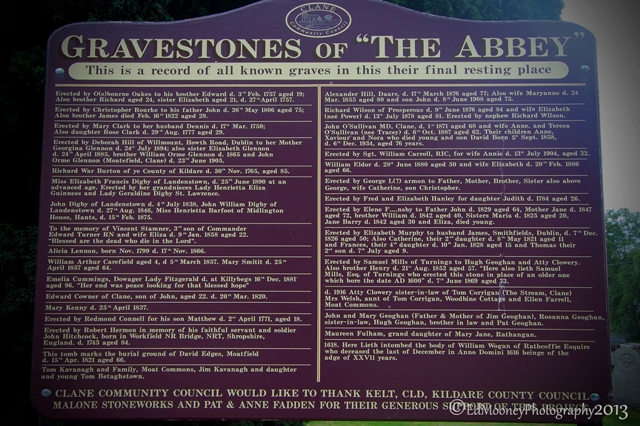Moving on just a short stroll from the ruins of the Franciscan Friary Lies an old church known as Clane Abbey. Initially both of these sites caused me some confusion, but a little research cleared this up. The Abbey’s connection with Christianity, predates the arrival St. Patrick. The original Monastery of Cluain Damh was founded by St. Ailbe, bishop of Ferns, in or around 520 AD, whom was followed by a St. Senchall as the second abbot. With the arrival of the invading Normans, the celtic abbey went into decline, and the Friary built on the monastery grounds became the eclessiastical center in Clane.
Located on the highest ground in the center of Clane we find the former parish church of St. Michael, known locally as Clane Abbey. To the east side of the former St. Michaels church, built against a free standing stone wall lies a Limestone table-top tomb from the 17th century, It belongs to a William Wogan of nearby Rathcoffey whom died and was intered here in 1616AD.
It is best known for hosting the famous Synod of Clane in 1162 and was the Church of Ireland’s home until a new church was built in Millicent in 1883. The church is said to have at one point been held by the Knights Hospitallers. The earliest reference I could find dates back to 1212AD. The site was described as a parish church in 1307, but by 1615 the chancel was said to be in ruin. The structure today consists of a battlemented four story tower to the west from possibly the 17th century with an apsidal church built in the late 18th century. Access to the tower is via a modern pointed archway in the south, however traces of the original round arched doorway which has been blocked can be seen in the west wall. Interestingly a 12th/13th century granite font was found in the wall of the tower, but it has since been moved to the nearby church of ‘St. Michael’ at Millicent.
Over time this medieval structure fell into disrepair – the roof caved in and some of the walls partially collapsed. Thanks to the hard work of the Clane Community Council the tower was made safe in the 1970s. During the 1980’s the building was restored and reopened as a community hall for the local population. The grounds of the Abbey have recently been landscaped into a Garden of Remembrance with an information board and plaques which record those buried on the site surprisingly there are quite a number of renowned Clane people.
Clane (“the slanted ford”) is a place of legend with a deep history. As a crossing point of the Liffey, it has been settled since the Stone Age and was on the “Road of Kings” between Tara and Naas. One interesting story tells of the killing of King Mesgegra in battle in 33 AD and how his queen, Buan, screamed so hard on being shown his severed head that her heart burst. There are plenty of interesting places nearby to visit such as the ruins of the Franciscan Friary and Bodenstown Church & Cemetery, watch out for some other interesting sites which I hope to bring to you soon.
For these and more of my images, why not visit my Website or join me on Facebook or Twitter.















Reblogged this on victormiguelvelasquez.
LikeLike
Great that the town came together to save and repurpose the space. Nice post Ed.
LikeLike
Thanks Rob, Its a rare occurrence but nice to see none the less 🙂
LikeLike
Oh, the pop of color is nice! But your B&W shots are fab. ~SueBee
LikeLike
Thank you, sometimes a little color is nice, glad that you like my mono shots, 🙂
LikeLike
Yikes quite the story to go along with these beautiful photos. Severed head and bursting heart…oh my!
LikeLike
🙂
LikeLike
Lovely photos and very interesting history.
LikeLike
Thank you, glad you liked, 🙂
LikeLike
Wonderful work as always, Ed. B&W really works for these. The vignetting adds to the mystery as well. Well done. 🙂
LikeLike
Yet again, great photos and fascinating history – thanks Ed!
LikeLike
Thank you Aine, much appreciated, 🙂
LikeLike
I so enjoy your photos of the historic architecture and ruins-the images are so evocative-I really liked the splash of color in these a lot-
LikeLike
Thank you, 🙂
LikeLike
The flowers are brightly colored and pictures in mono chrome
Flowers are beautiful and alive..others are old as tomb stones
High it stands still..will last long after the flowers have died and gone
LikeLike
🙂
LikeLike
🙂
LikeLike